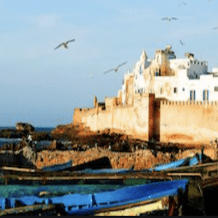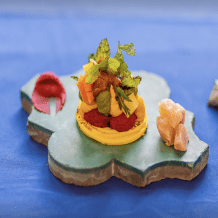
Rabat, the capital of Morocco retains a charming relaxed atmosphere in the center despite its 1.2 million population. Magnificent tall palm trees stretch down the main Avenue Hassan II passing the main station and the red Parliament building opposite the well known and classically Art Deco Balima Hotel. Balima Hotel in Rabat was used to be the premier hotel year ago with locals and tourists sitting in the open air café area. Cafes and patisseries are abound in Rabat like most other Moroccan cities. International five star hotels now include the Sofitel Jardin De Roses, Golden Tulip, La Tour Hassan and the Dawliz. Rabat is also home to several charming Riads with private gardens and courtyards such as Villa Mandarine, Riad Kalaa and Riad Art.
Rabat is also a university city with the famous Mohammed V University, as well as being the centre of government with ministries in the ministers’ quarter and the modern suburb of Rabat Agdal. The Ville Nouvelle has a 1930’s feel with its shops lining the streets. The towering spires of the Saint Peter’s functioning Roman Catholic Cathedral also adorn the city center.
Rabat is still an important center for textiles and shirts are good value. However change has come to the Moroccan capital. The tram system is now fully functional and It has become an important offshore center and it is the headquarters of Maroc Telecom the main telecommunications company.
Rabat was recently awarded second place in “Top Travel Destinations of 2013” by CNN. It has also recently been named as a UNESCO world Heritage site. A new world class yachting marina catering for 248 yachts has been created on the banks of the Bouregreg river near neighboring Salé. A new bridge spans the river between the two cities. A major new tourism development program backed with substantial Gulf investment is boosting Rabat and Salé’s tourism appeal. Rabat is a noted green city with extensive forests. The Royal Dar Es Salam golf club is a world class course and there are good opportunities for riding.
There are a number of historic sites which have always drawn tourists to Rabat. The medina is smaller and less complicated than Fez or Marrakech but is still a place for good deals especially carpets and leather goods. There are picturesque views of the old harbor and battlements.
The city walls and gates surround the centre and the Royal Palace grounds called Mechaour which you can sometimes enter, though you have to keep to the main pathway. It reminds you that this is a Royal capital too.
The Chellah Necropolis is an historical ruin outside the main gates . It is a national treasure which was in existence in Phoenician, Carthaginian and Roman times as the port of Sala Colonia but it was ruined in the tenth century and thereafter used by the Merinid dynasty as a necropolis. The Roman ruins of Sala Colonia have been excavated. It is one of the most striking ruins in Morocco with its Merenid built walls and towers. From the Chellah there is an amazing view across The Bouregreg river with Salé and the rolling countryside beyond.

The Kasbah of the Oudaias is the original site of the rabat or fort which gave the capital its name where the Sultan’s forces were stationed to keep rebellious Berber tribes under control. It was built by the Almohads and its walls are 10 ft thick and 30ft high. The Oudaias were an Arabic tribe that entered Morocco in the 13th century and served the Sultan. The grand Bab Oudaia gate with its decorative arches leading in to the Kasbah was built by Sultan Yacoub el Mansour. Rabat became home to Arab and Jewish refugees from Spain and the white washed Andalusian houses bear witness to this. The La Jamaa el Atiq mosque was founded by The Almohad leader Abdl Moumen in 1150 and is the oldest mosque in the city. There is also the Oudaia Palace museum dating from 1694 and the Andalusian garden. The museum displays traditional ceramic designs and has period furnishings in the apartments. There is also an impressive collection of Moroccan handicrafts including costumes, jewelry, pottery and tribal musical instruments and a replica of a Berber nomad tent.

The other great monument which tourists must see is the Hassan Tower which was built by the Almohad Sultan Yacoub el Mansour in 1199 as part of a building program which included the Koutoubia mosque in Marrakech and the Giralda in Seville. When the Sultan died the building remained unfinished and the shock from the great Lisbon earthquake in 1755 brought down the marble pillars. The Tower remains as arresting a sight as Koutoubia in Marrakech. The King Mohammed V mausoleum is nearby which also contains the tomb of King Hassan II and his brother Prince Moulay Abdullah. The mausoleum is guarded by Royal guards in scarlet uniforms with a white burnous.
Neighboring Salé across the Bouregreg river was famous as the home of the Salé Rovers or Barbary pirates who had been expelled from Spain by King Philip III in 1609. Together with Rabat citizens they formed the Bouregreg republic which was eventually disbanded in 1818.The pirates raided as far afield as Iceland, Ireland and the Southern coast in England. The Austria navy bombarded Salé in 1829 as did the French navy.
Written by Colin Kilkelly
For More Information about a Rabat Tour
Morocco’s Imperial Cities, Seaside Resorts,Sahara Desert,Berber villages, A Taste of Morocco, Magical Kasbahs, Ruins & Waterfalls, Absolute Morocco, The Best of Marrakech, Fes, and Ouarzazate






